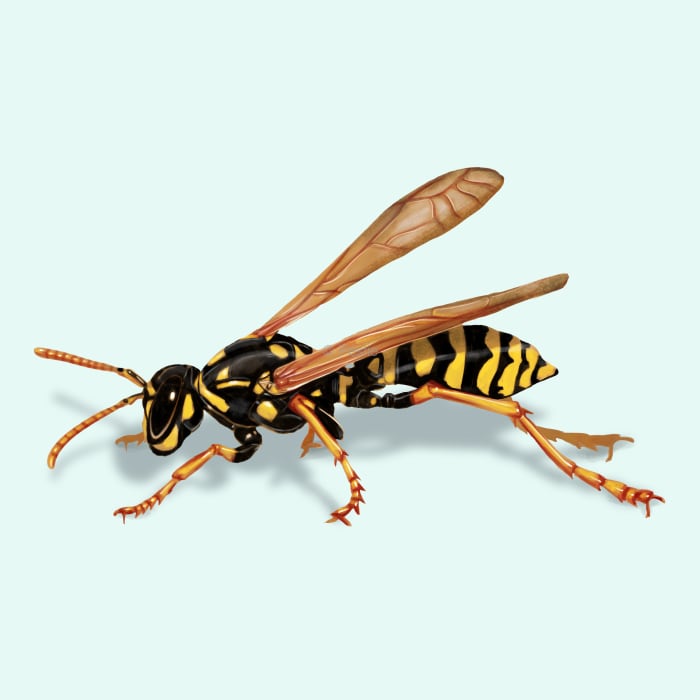How to identify and get rid of paper wasps

The guest that makes nests: tackling paper wasps around your home
Why does it seem like paper wasps know where your front door is? They always seem to make their papery nests in the most inconvenient of places. Every time you open the door, you wonder if you’ll get an unpleasant sting for crossing the wrong territory.
Paper wasps are semi-social wasps that create their nests from a paper-like substance. They create the paper nests by mixing dead wood and plant stems with their saliva. The combs are open and facing down, looking very much like an umbrella. The nest will often rest on a stem-like structure called the petiole of the nest.
Fortunately, paper wasps aren’t as aggressive as their closely related yellowjackets or hornets, but if you threaten their nest, there is a good chance they’ll defend it with a nasty sting.
How to identify paper wasps
Paper wasps belong to the genus Polistes and have a very distinct body shape with long legs and a long abdomen. Depending on the species, they can have different markings, but they typically have some combination of black, brown, and yellow. When looking from above, the thorax has a V-shaped marking starting from the head and moving out to the wings.
To identify a paper wasp infestation, look for nests attached to sheltered areas like eaves, ceilings, or plant branches. If you see many wasps flying around your home or garden, it might mean they've made a nest nearby.
How big are paper wasps?
Paper wasps can range from ½ to 1.5 inches in length.
What other wasps look like paper wasps?
The name paper wasp has also been applied to some hornets and yellowjackets, as they, too, make nests out of a paper-like material. However, yellowjackets have thicker bodies, and hornets build larger, enclosed nests. Some may confuse a mud dauber with a paper wasp. The biggest differences are the long thin waist of mud daubers, and their nests made from mud.
Where do paper wasps live?
Paper wasps are found throughout North America, with 22 species identified so far. They like to make their nests under some sort of cover or eaves. They can be found on or near plants with caterpillars or other insects. Look for them in attics, under roof eaves, behind shutters, or in bushes and trees around your yard.
How to get rid of paper wasps
The best way to get rid of paper wasps without chemicals includes:
- Removing nests during early morning or late evening when wasps are less active.
- Using a hose to knock down nests from afar.
- Placing decoy nests around your property, as wasps are territorial and won't build near other nests.
After you’ve removed the nests, it’s a good idea to spray an insect barrier around your home to keep paper wasps from wanting to settle back in. Pestie offers a DIY, pro-grade solution to keep pests out around and in your home. Our easy-to-use kit makes pest control a breeze!
Treat paper wasps with Pestie
If you're still having trouble keeping paper wasps away, the best option is to use a pro-grade, effective pest control solution like Pestie.
Pestie is a do-it-yourself pest control solution that's specially designed to keep paper wasps and other pests away from your home.
With Pestie, you can rest easy knowing that your living space is protected and free of creepy crawlies. And the best part? It's designed for people, pets, and the planet, so you can say goodbye to harsh chemicals and hello to peace of mind!
- Save hundreds compared to traditional annual pest plans
- People, pet, and planet-friendly
- Pro-grade customized formulas
Quick facts
How dangerous are Paper Wasps?
Medium danger risk
Paper wasps aren’t known for being aggressive around people, but they have a smooth stinger that allows them to sting multiple times without dying. It’s best to be cautious around nests and to knock them down while they are still small.
If you are allergic to bee stings, you could also have an allergic reaction to wasp stings.
- Scientific name
Family - Vespidae
- Other common names
Umbrella Wasps
- Colors
Black, brown, red, yellow
- Life span
About 1 year for queens, but workers and males live only for one season
- Diet
Caterpillars, small insects, nectar, sap, fruit
Paper wasps play a significant role in our ecosystems. Not only do they eat pest caterpillars, but they can also help with pollination and are food to other vertebrates and parasitic insects.








